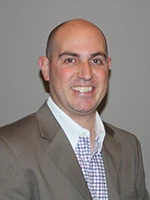
Keeping the course in top shape starts with healthy turf for Brandon Schindele, superintendent at Edina Country Club in Edina, Minn. All the controls in the world aren’t going to do the job if the plants are not otherwise growing as they should.
“The first step is to know your turf varieties and what it takes to make each type thrive,” says Schindele. “They each have their individual characteristics and differing optimum conditions for growth. My bent likes less fertility, less water and acidic soil conditions. I gear my program for those plants where they are predominant. I also have to take the soil and weather conditions into consideration. On the sand-based USGA profile greens I spoon feed them with a little fertilizer on a weekly or biweekly basis. I watch weather conditions to provide just enough water needed for growth, but not too much.”
The course was originally constructed in 1923 and went through a massive renovation in 2010. The rough is a mixture of Kentucky bluegrass, Poa and perennial rye.
“I’m basically dealing with what’s out there. I’ve not gone through a big push to make it uniform – instead I’ve worked with the natural selections,” says Schindele. “I allow the grass that is most successful there to continue to live there. I have then developed the maintenance programs for those grasses in those specific growing conditions.”
He also keeps track of other conditions that impact plant health. Microclimates have a bearing in specific areas. These microclimates include air movement, sun or shade, changing light patterns, seasonal changes and surrounding plant growth. All have to be taken into consideration to keep each individual grass plant growing at its best. Schindele also employs other cultural practices to reduce stress.
“If weather conditions are such that mowing on a given day will stress the plants, I’ll skip it that day,” he says. “Maybe rolling will provide a playable surface without the stress of mowing. If so, that is what will be done.”
Proper plant health many times does require judicious applications of preventive fungicides. Just like humans, healthy plants can get sick. When you know your plants and what they are susceptible to, especially under upcoming conditions, a good plan for preventive applications should be part of your overall program.
For instance, Schindele says, “If the forecast calls for 100 degree days, 70 degree nights with a dew point of 70 degrees, we’ll take preventive action by applying a fungicide.” He adds, “Another example is preventing snow mold. We know that in this part of the country, without preventive measures, we’ll have a real problem. So we proactively apply fungicides at the proper time. It’s important to be ahead of the game so you don’t get to the point that the only option is a curative approach, which can be much more difficult.”
Even when you do everything you think you should, sometimes you’re thrown a curve. Your turf was healthy, but something unexpected came along. You’ve got to play catch-up and that is going to take a while. That’s where communication is so important. Schindele is a big believer in using every means possible to communicate with the members. He uses email, often with photos or You Tube attachments to keep them informed. He also encourages comments and questions from them including his email address for feedback.
“If I have developed a level of confidence and trust on their part, they don’t second guess my decisions,” he says. “They trust that I am the agronomist and know what I am doing. They have to live with my decisions – and so do I.”
Latest from Golf Course Industry
- From the publisher’s pen: Conscientious of a bigger role
- Bernhard and Company partners with Laguna Golf Phuket
- Terre Blanche showcases environmental stewardship
- VIDEO: Introducing our December issue
- Bernhard and Company introduces Soil Scout
- Nu-Pipe donates to GCSAA Foundation’s Centennial Campaign
- GCSAA enhances golf course BMP tool
- Melrose leadership programs sending 18 to 2026 GCSAA Conference and Trade Show





